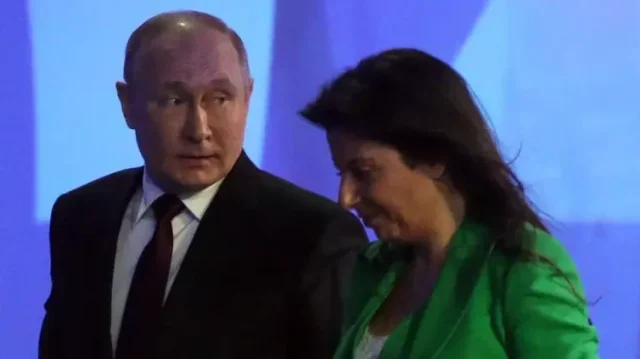The United States has recently accused Russia of interfering in the 2024 presidential election and has announced sanctions against executives from Russian state media outlets. This latest revelation from the White House about Russia’s attempts to sway the election comes as no surprise to those familiar with the Kremlin’s disinformation tactics during previous American elections.
During the 2020 campaign, the Kremlin utilized state-sponsored media outlets such as RT (formerly Russia Today) and Sputnik to disseminate content questioning the legitimacy of the U.S. democratic process. Additionally, Russian-sponsored networks of bots and trolls spread polarized misinformation and conspiracy theories online.
In response, the U.S. has seized a network of Russian-controlled internet domains and imposed sanctions on ten individuals, including Margarita Simonyan, the editor-in-chief of RT, for “activities aimed at undermining public confidence in our institutions.” These sanctions include freezing assets in the U.S. and potentially restricting any U.S. citizen or company from engaging with them.
The U.S. also accused two Moscow-based RT managers, Kostiantyn Kalashnikov and Elena Afanasyeva, under anti-money laundering laws for allegedly paying U.S. content creators to spread “pro-Russian propaganda and misinformation” within the U.S. Merrick Garland, the U.S. Attorney General, stated that Russia was attempting to influence the upcoming presidential election and undermine U.S. support for Ukraine.
The tactics identified by the U.S. Department of Justice (DOJ) align with what has been detailed in the new book “Russia, Disinformation and the Liberal Order” by myself and my co-authors. Here are five key tactics used by Russia to manipulate information and influence public opinion:
1. Leveraging Local Influencers
The DOJ accuses RT officials of paying a Tennessee-based company around $10 million to produce social media content aligned with Russian interests without disclosing the Russian government’s involvement. Many influencers connected to this Tennessee company claimed editorial control over their content and denied any links to Russia. However, this tactic fits the pattern identified in our research.
RT has long collaborated with right-wing populist media and often mirrors the style and practices of U.S. right-wing media. It frequently links to its articles, promotes right-wing media personalities, and distributes their programs on its platforms. RT offers platforms, funding, and editorial freedom to media figures in targeted states whose genuine beliefs align with Russian interests, leveraging the fact that people are more likely to believe repeated claims, whether true or not.
2. Disseminating False News Outlets
As part of the recent case, the U.S. seized a network of internet domains used to promote false information aimed at specific U.S. demographic groups. Disguised as local news sites, these domains exploit social concerns and controversies to amplify key Russian talking points.
Previously, the Kremlin-backed Internet Research Agency created a fake left-wing news site and deceived unsuspecting freelancers into contributing content to Russian information operations. RT has shown no qualms about disguising its connections with other operations and media groups. Our research indicates that these sites often cross-reference each other and other so-called anti-mainstream sites to boost credibility with certain online demographics.
3. Exploiting Societal Fears
Another common tactic is to link content to prevalent fears and concerns within a society. For example, Russia has not imported cultural warfare to the U.S. but has skillfully capitalized on American anxieties about it. Russian media operations have spotlighted these issues without engaging directly.
When Russian sites pose as local sources, they prioritize familiar topics, often embellishing controversial issues with a mix of real and fabricated information. The public struggles to distinguish between the two, and initial assumptions often prevent them from attempting to verify the information.
4. Inverting the Narrative
Moscow has repeatedly denied involvement in influence campaigns, similar to its response to the 2018 Novichok poisoning accusations in Salisbury, UK. Russian officials promoted a complex network of conspiracy theories mirroring the accusations against UK and U.S. security services.
In the current case, Russian authorities have once again attempted to “flip the script,” dismissing U.S. allegations as a product of “Russophobia.” The Russian ambassador in Washington, Anatoly Antonov, and Russian Foreign Ministry spokeswoman Maria Zakharova have employed similar tactics, accusing the U.S. of becoming a “totalitarian neoliberal dictatorship” — a term echoing the Russian government’s use of misinformation.
5. Utilizing Humor
The Russian state frequently uses humor strategically, with RT leading the way in employing humor to legitimize Russian actions or deflect criticism. RT’s approach often involves incorporating itself into the joke, using foreign criticisms as part of its advertising campaigns.
This strategy was evident in Simonyan’s sarcastic response to recent accusations, rejecting them as U.S. alarmism about RT’s supposed power. Such responses exemplify how RT embraces its “populist pariah” status to further its influence.
Russia continues to refine its methods for influencing international agendas, and there is no sign that these tactics will cease anytime soon. Understanding these strategies can help counteract their impact and protect democratic processes from manipulation.





